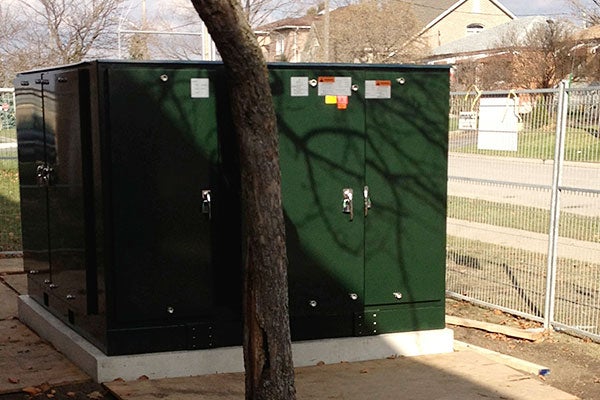
U of T Engineering Makes Toronto Hydro a Little Smarter
Published: December 19, 2012
Toronto’s electrical system is a little smarter now, thanks in part to a University of Toronto team led by Professor Reza Iravani of Electrical & Computer Engineering.
Toronto Hydro has installed a 250-kW, 48-module battery storage unit at a North York community centre that is strong enough to power a small street for one hour. But what makes the unit unique, says Iravani, is that it is connected to the Toronto Hydro power grid, and can store energy during off-peak times to later release it back into the grid as needed.
The system can also store and release power added to the grid by solar energy panels installed at the community centre.
The project was developed by a consortium comprising Toronto Hydro, Markham-based eCAMION, Korean battery manufacturer Dow-Kokam and U of T. Iravani and his team developed and implemented the algorithms that integrate the battery system through a power electronic converter in the Toronto Hydro grid.
“This is not just an academic research project,” said Iravani, the coordinator of U of T’s Centre for Applied Power Electronics. “We had to deliver a functioning system with the high degree of reliability that Toronto Hydro requires."
"We’re providing the brain for the operation of this battery system to appropriately integrate it into Toronto Hydro’s distribution grid.”
Depending on information the energy storage unit receives from the distribution grid, it will either store power in the battery system, or, if the grid is overloaded, discharge energy back into the system.
The Roding Community Centre battery unit is the first of three that will be installed in a Toronto Hydro 'smart grid' pilot project. A smart grid uses information and communications technology to automatically gather and act on supply and consumption information to improve the efficiency, reliability, cost and sustainability of electricity production and distribution.
But smart grids need coordination, timing algorithms and communication protocols in order to work.
“It requires major changes in the conventional approach for the operation of utility grids,” said Professor Iravani.
In a news release, Toronto Hydro noted that the current electrical infrastructure is aging, with some of it dating back to the 1940s. Upgrading the system to include “smart technology” will give the utility the flexibility to integrate renewable technologies such as solar panels and wind turbines, charge electrical vehicles, reduce peak demand, lower energy costs and reduce pollution.
The project is supported by Sustainable Development Technology Canada.



